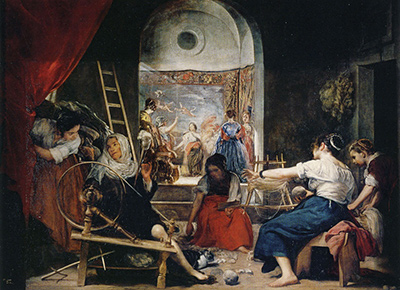The Spinners (Las Hilanderas)
One of the most admired and complex paintings by the Spanish painter Diego Velazquez is this one, Las Hilanderas. Also known as The Spinners, or The Fable of Arachne, the painting is a depiction of the mythological tale of Arachne, which is originally described in Ovid's Metamorphoses, book VI.

In this story, a weaving competition takes place between Arachne and Pallas Athena, the patron goddess of weaving. After hearing of Arachne's boastful claims that she possessed spinning skills which could not be matched, the goddess challenged Arachne. Upon seeing the scene depicted on Arachne's completed tapestry, which she perceived to show the gods in a negative light, Pallas Athena turned Arachne into a spider, condemning her to weave forever. It is this competition we see about to commence in The Spinners. Rather than portraying the climactic scene of the tale, where Arachne experiences her transformation, Velazquez chose instead to render the scene just before the contest is truly underway.
While the subject of mythology was a common one for painters of the Renaissance or Baroque eras, it is Velazquez's avoidance of the primary drama of the story that makes this painting so unique and enigmatic, leaving many to ponder its complexities even today. Often interpreted as an allegory for the arts themselves, The Spinners is viewed by many to be a commentary on all creative endeavours; a representation of craft against high art, with the Arachne serving as craft and the goddess symbolizing fine arts. Still other analysts assert that possibly Diego Velazquez was merely claiming in this piece that to create substantial works of art, one must do the hard work that is required.
Some details pertaining to the commission of The Spinners are uncertain, further lending an enigmatic air to the painting. Based on the complexity of composition and other stylistic elements such as economical use of paint, tones of lightness, and the unmistakable Italian Baroque influence, many scholars have dated the piece to have been created in 1657. However, this has been disputed by some, who date the painting somewhere between 1644–50. What is certain is that The Spinners was painted for King Philip IV’s huntsman, Don Pedro de Arce. While Diego Velazquez's thoughts behind creating The Spinners will likely never be made clear to us, the fact that it leaves us discussing, pondering, and interpreting so deeply all these many years later is the mark of a great work of art, indeed.